Plötzensee Prison
Plötzensee Prison (German: Justizvollzugsanstalt Plötzensee, JVA Plötzensee) is a men's prison in the Charlottenburg-Nord locality of Berlin with a capacity for 577 prisoners, operated by the State of Berlin judicial administration. The detention centre established in 1868 has a long history; it became notorious during the Nazi era as one of the main sites of capital punishment, where about 3,000 inmates were executed. Famous inmates include East Germany's last communist leader Egon Krenz.
 | |

| |
| Location | Charlottenburg-Wilmersdorf Berlin, Germany |
|---|---|
| Status | Operational |
| Population | 577 |
| Opened | 1879 |
| Managed by | Senate of Berlin |
History
The prison was founded by resolution of the Prussian government under King William I and built until 1879 on the estates of the Plötzensee manor, named after nearby Plötzensee Lake (Plötze is the local German name of the common roach, cf. Płoć in Polish). The area divided by the Berlin-Spandau Ship Canal opened in 1859 was located at the outskirts of the Tegel forest northwest of the Berlin city limits in the Province of Brandenburg. The theologian Johann Hinrich Wichern had established the Evangelical Johannesstift borstal nearby, which in 1905 moved to Spandau–Hakenfelde. In 1915, the lands east of the canal with Plötzensee Lake were incorporated into Berlin (the present-day Wedding district), the remaining area around the prison walls became part of the Berlin Charlottenburg borough upon the 1920 Greater Berlin Act. Since 2004, it belongs to the Charlottenburg-Nord locality.
The original name of what is today Haus 1 was Strafgefängnis Plötzensee, which also translates to Plötzensee Prison. Up to 1,400 inmates lived on premises of 25.7 ha (64 acres) including a church and a Jewish prayer area, then the largest prison of the German Empire. After World War II, the buildings demolished by the bombing of Berlin were rebuilt and housed a youth detention center (Jugendstrafanstalt Berlin) for offenders between the ages of 14 and 21. When it in 1987 moved to a newly built annex on Friedrich-Olbricht-Damm in the west, Haus 1 of Plötzensee Prison again became a men's prison with capacity for 577 inmates.[1] Upon the end of the Cold War and German reunification, the last communist East German leader Egon Krenz, convicted for manslaughter by Schießbefehl order at the Berlin Wall, from 2000 until 2003 served his sentence there.[2] Today about one third of the inmates are incarcerated for repeated fare evasion.
In 1983, a modern women's prison was built south of Friedrich-Olbricht-Damm on the Bundesautobahn 100 (Stadtring) highway, since 1998 it houses the JVA Charlottenburg for about 300 adult male prisoners, mainly drug addicts.
One in three inmates of the prison is incarcerated for repeated public transport fare evasion.[3][4]
Plötzensee Memorial

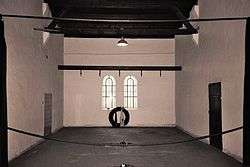
During Imperial and Weimar Republic eras until 1933 there were 36 executions carried out in Plötzensee, all for murder and all by beheading with an axe according to the old German Strafgesetzbuch penal code. After the Nazi Machtergreifung, the prison housed both regular criminals and political prisoners. Plötzensee was one of eleven selected central execution sites established in 1936 throughout Germany by the order of Adolf Hitler and Reich Minister of Justice Franz Gürtner. Each was operated by a full-time executioner carrying out the rising numbers of death sentences, especially after the penal law was again tightened in World War II. By a 1943 agreement with the OKW they became also responsible for the execution of Wehrmacht members according to German military law. The convicts were beheaded by a stationary guillotine (Fallbeil), from 1942 also by hanging. During the Nazi regime, an official record of 2,891 people convicted by the Berlin Kammergericht, the notorious "People's Court" under Roland Freisler and several Sondergerichte, were executed in Plötzensee, initially with an axe in the prison's courtyard. From 1937 the convicts were beheaded with a guillotine brought from Bruchsal Prison and installed in a backyard work shed, a ground-level brick building near the prison walls, to where the victims had to walk from a nearby cell block. In 1942, a beam was assembled in the same room, serving as gallows for up to eight victims at one time. The bereaved were obliged to pay a fee of 1.5 Reichsmarks for each day the detainee had spent in prison plus an extra execution charge of 300 Reichsmarks.
Executions of opponents of the Nazi regime
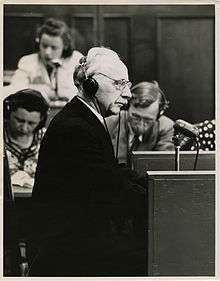
About half of those executed were Germans, most of whom were sentenced to death for acts of resistance against the Nazi regime, among them members of the Red Orchestra, the 20 July plot and the Kreisau Circle. 677 executed prisoners were from Czechoslovakia, among them many members of the Czech resistance to Nazi occupation from 1938-39 onwards. 253 death sentences were carried out against Poles, and 245 against French citizens. These people included both the members of resistance organizations and people who were deported to Germany for forced labour. About 300 were women.
After execution, their bodies were released to Hermann Stieve, an anatomist at the medical college of what is now Humboldt University of Berlin. He and his students or assistants dissected them for research purposes. Stieve was especially interested in the effects of stress on the menstrual cycle, and wrote 230 papers based on this research, among them one that demonstrated that the rhythm method was not an effective method of preventing conception.
After an RAF air raid in the night of 3 September 1943 irreparably damaged the guillotine and destroyed large parts of the prison buildings, State Secretary Curt Rothenberger in the Reich Ministry of Justice via telephone ordered the immediate execution of the Plötzensee condemned. About 250 people—six of them "erroneously"— waiting in rows of eight were hanged during the so-called Plötzensee Bloody Nights from 7 to 12 September. The last execution was carried out on 20 April 1945. The remaining inmates were liberated by the Red Army in the course of the Battle of Berlin five days later.
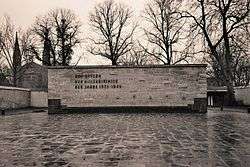
Today the execution shed is a memorial site operated by the Memorial to the German Resistance institution to commemorate those executed by the Nazis. Separated from the prison area, it was dedicated by the Senate of Berlin on 14 September 1952 in the remaining two rooms with its drain and the preserved gallows. The guillotine had been dismantled after the war and disappeared in the Soviet occupation zone. Onto the execution room a memorial wall was built "To the Victims of Hitler's Dictatorship of the Years 1933–1945". In 1963, the Catholic Diocese of Berlin erected its memorial for the victims about 2 km (1.2 mi) to the west in the commemorative church of Maria Regina Martyrum, the nearby Protestant Church of Plötzensee was inaugurated in 1970, featuring a Danse Macabre cycle (Plötzenseer Totentanz) by Alfred Hrdlicka. Both institutions are site of the annual Ecumenical Plötzensee Days. Several streets in the surrounding Charlottenburg-Nord housing estates were named after executed resistance fighters.
Executed prisoners
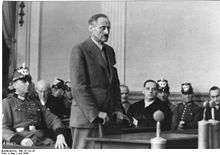


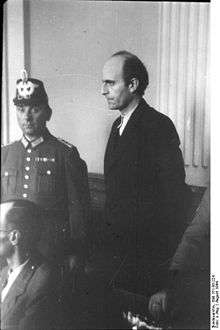
- Abdulla Aliş
- Rita Arnould
- Marianne Baum[5]
- Cato Bontjes van Beek
- Liane Berkowitz
- Robert Bernardis
- Heinz Birnbaum[6]
- Eugen Bolz
- Eva-Maria Buch
- Musa Cälil
- Hans Coppi
- Hilde Coppi
- Alfred Delp
- Benita von Falkenhayn
- Erich Fellgiebel
- Eberhard Finckh
- Julius Fučík
- Jakob Gapp[7]
- Erich and Elizabeth Gloeden, and Elisabeth Kuznitzky
- Carl Friedrich Goerdeler
- Fritz Hermann Goerdeler
- John Graudenz
- Nikolaus Gross[8]
- Hanno Günther[9]
- Hans Bernd von Haeften
- Albrecht von Hagen
- Otto and Elise Hampel, the inspiration for Hans Fallada's 1947 protest novel, Every Man Dies Alone
- Georg Hansen
- Arvid Harnack
- Mildred Harnack
- Paul von Hase
- Ulrich von Hassell
- Theodor Haubach[10]
- Egbert Hayessen
- Wolf-Heinrich Graf von Helldorf
- Albert Hensel
- Liselotte Herrmann
- Helmut Hirsch
- Erich Hoepner
- Caesar von Hofacker
- Helmuth Hübener (youngest victim, only 17 years old)
- Ewald von Kleist-Schmenzin
- Hilde Jadamowitz[11]
- Friedrich Gustav Jaeger
- Heinz Joachim[12]
- Marianne Joachim[12]
- Walter Küchenmeister
- Otto Kiep
- Johanna Kirchner
- Nikolaus Christoph von Halem
- Hans Georg Klamroth
- Friedrich Klausing
- Sala Kochmann[13]
- Theodor Korselt
- Alfred Kranzfelder
- Karlrobert Kreiten
- Adam Kuckhoff
- Carl Langbehn
- Julius Leber
- Wilhelm Leuschner
- Hans Otfried von Linstow
- Hilde Loewy[14]
- Hans-Georg Mannaberg[15]
- Gerd Meyer[16]
- Hanni Meyer[17]
- Herbert Michaelis
- Helmuth James Graf von Moltke
- Ernst Munzinger
- Renate von Natzmer
- Benno Neuburger
- Arthur Nebe
- Helmut Neumann[18]
- Vera Obolensky
- Paul Ogorzow
- Erwin Planck
- Johannes Popitz
- Rudolf Redlinghofer
- Adolf Reichwein
- Heinz Rotholz[19]
- Siegbert Rotholz[20]
- Lothar Salinger[21]
- Rudolf von Scheliha
- Fritz-Dietlof von der Schulenburg
- Harro Schulze-Boysen
- Libertas Schulze-Boysen
- Elisabeth Schumacher
- Kurt Schumacher
- Ulrich Wilhelm Graf Schwerin von Schwanenfeld
- Robert Stamm
- Berthold Schenk Graf von Stauffenberg (brother of Claus von Stauffenberg, leader of Operation Valkyrie)
- Werner Steinbrinck[22]
- Helmuth Stieff
- Carl-Heinrich von Stülpnagel
- Maria Terwiel
- Elisabeth von Thadden
- Fritz Thiele
- Ernst Volkmann[23]
- Adam von Trott zu Solz
- Peter Yorck von Wartenburg
- Josef Wirmer
- Erwin von Witzleben
- Gerhard Steinacher[24]
- Walter Neugebauer[25]
- Emmy Zehden
See also
References
- "Justizvollzugsanstalt Plötzensee". Berlin.de. 4 August 2017. Retrieved 16 October 2017.
- Neilan, Terence (16 October 2017). "WORLD BRIEFING". Nytimes.com. Retrieved 16 October 2017.
- Schwarzfahrer hinter Gittern, die Tageszeitung, 2010
- Jeder Dritte in Plötzensee sitzt wegen Schwarzfahrens, Der Tagesspiegel, 2008
- Cox 2009, p. 133
- Cox 2009, p. 133
- Online, Catholic. "Bl. Jakob Gapp - Saints & Angels - Catholic Online". Catholic Online. Retrieved 16 October 2017.
- "The Kreisau Circle" p.47(12) Gedenkstatte Deutscher Widerstand
- "Resistance by Young People" p.42(13) Gedenkstatte Deutscher Widerstand
- "The Kreisau Circle" p.25(12) Gedenkstatte Deutscher Widerstand
- Cox 2009, p. 133
- Cox 2009, p. 133
- Cox 2009, p. 133
- Cox 2009, p. 133
- Cox 2009, p. 133
- Cox 2009, p. 133
- Cox 2009, pp. 133-34
- Cox 2009, p. 134
- Cox 2009, p. 134
- Cox 2009, p. 134
- Cox 2009, p. 134
- Cox 2009, p. 133
- de:Ernst Volkmann (Kriegsdienstverweigerer)
- "Falkensee: Walter Neugebauer - Aktionsbündnis Brandenburg". Aktionsbuendnis-brandenburg.de. Archived from the original on 16 October 2017. Retrieved 16 October 2017.
Sources
- Brigitte Oleschinski: Gedenkstätte Plötzensee. Berlin: Gedenkstätte Dt. Widerstand, 1997 (3. Auflage), ISBN 3-926082-05-4
- Cox, John M., Circles of Resistance: Jewish, Leftist, and Youth Dissidence in Nazi Germany, Peter Lang, 2009. ISBN 978-1-4331-0557-9
External links
| Wikimedia Commons has media related to JVA Berlin-Plötzensee. |